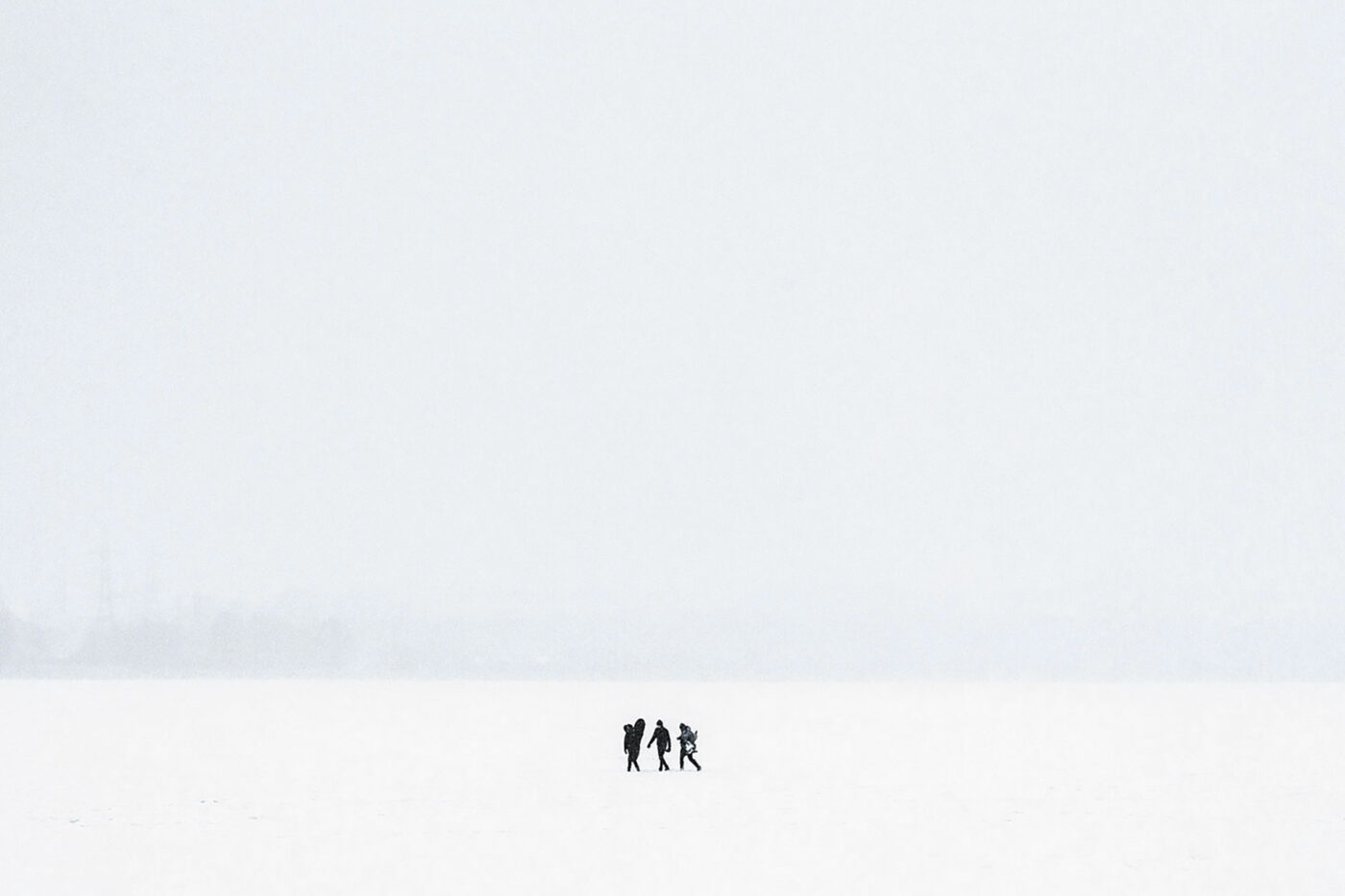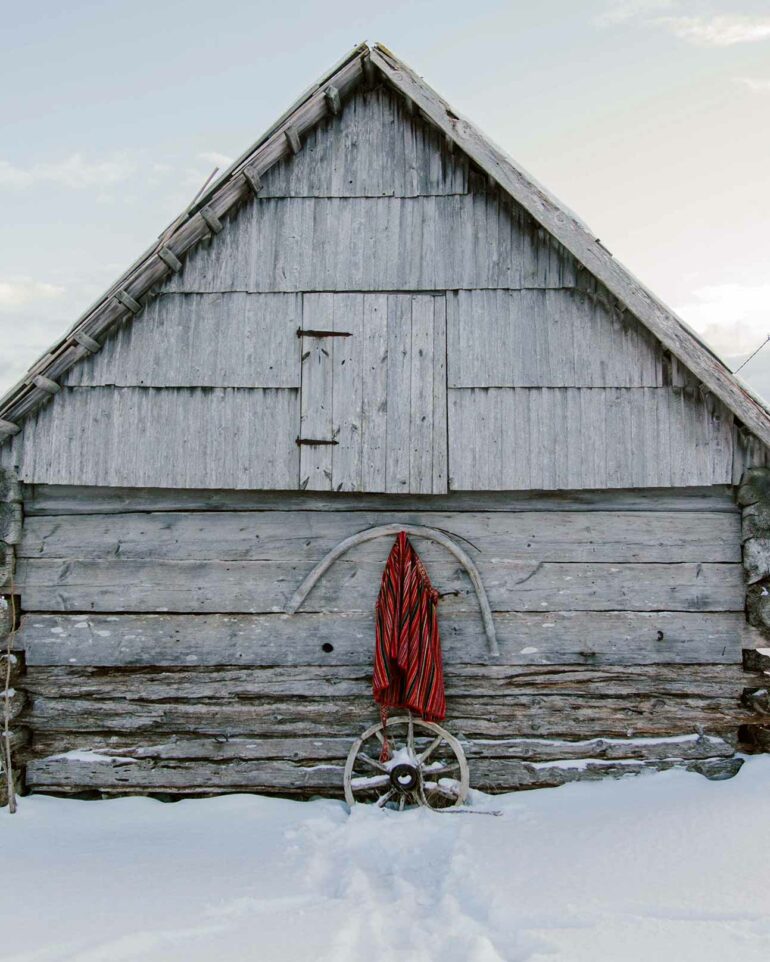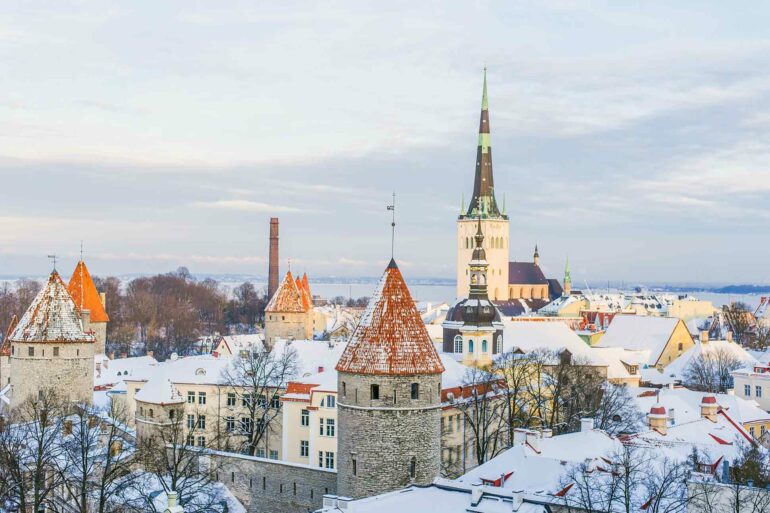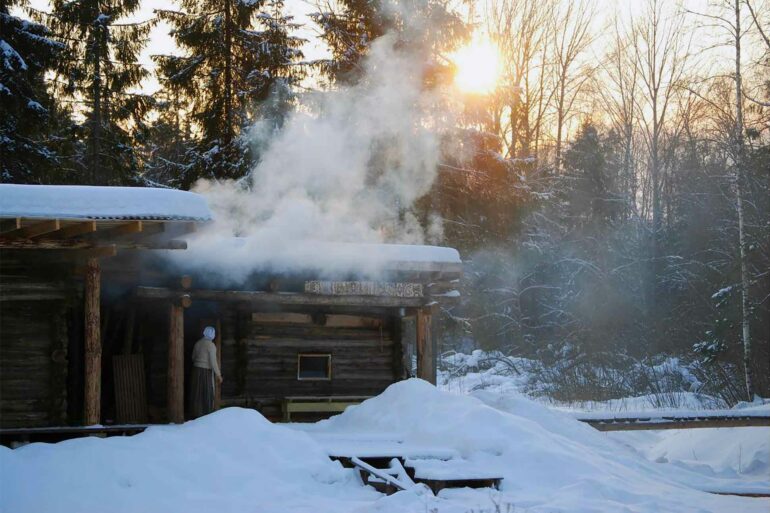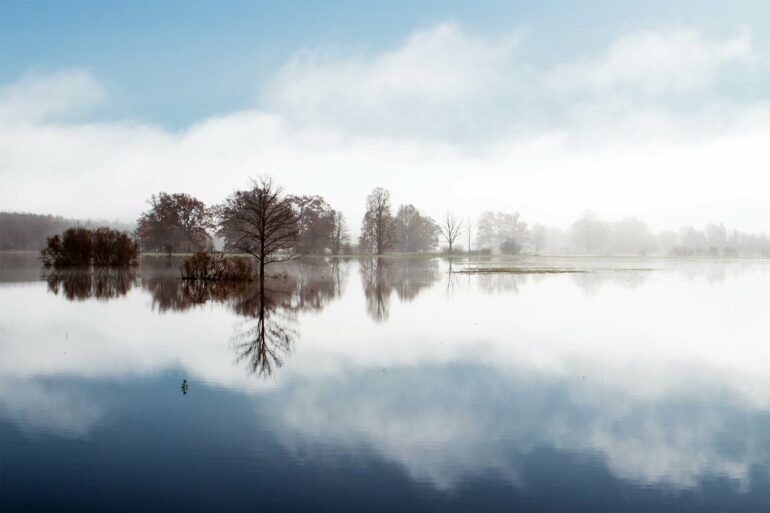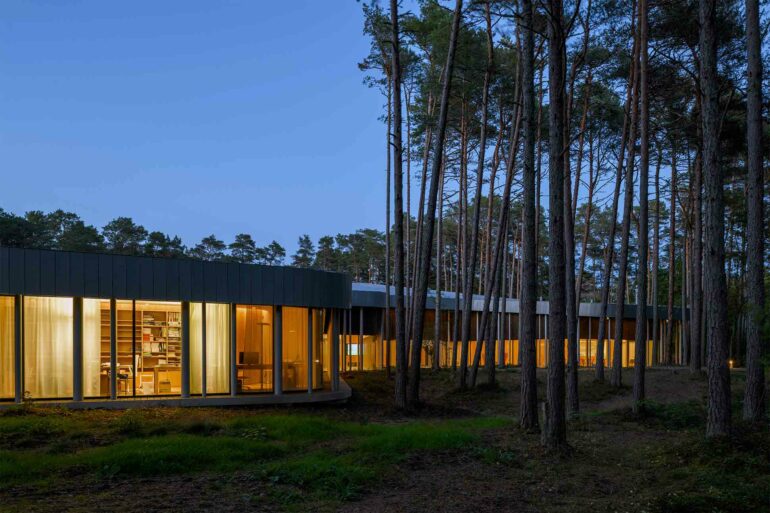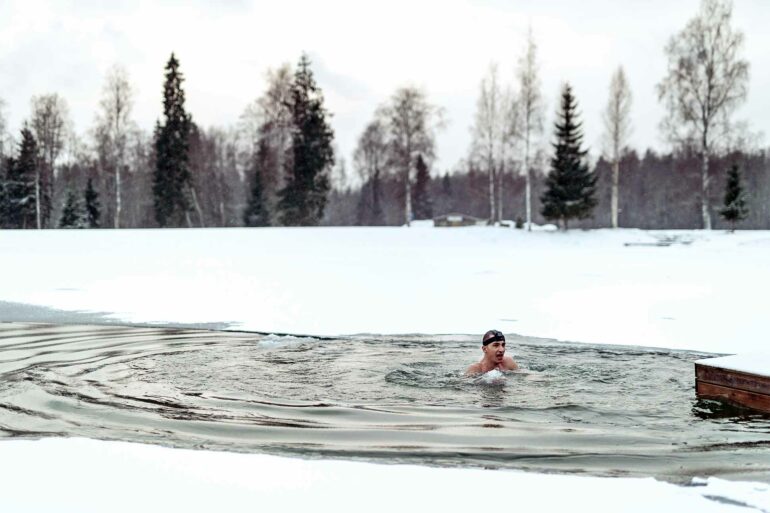A centuries-old tradition with enduring appeal, Estonian smoke sauna leaves intrepid first-timer Mark A. Thompson feeling reborn in Tallinn. A sensuous revelation for body and mind.
If someone told you that you could restart your life like you restart your computer, most likely you would be as tempted as I am – even if it means plunging into the bone-chilling waters beneath the ice of a frozen pond in Southern Estonia in the dead of winter. And not just once, but repeatedly; and naked at that.
“Inhale, and now, four more times,” counselled Eda Veeroja, proprietor of Mooska Farm where the smoke sauna traditions of Old Võromaa date from the 13th century.
Though I have visited Estonia previously – and fallen in love with the medieval Old Town charms of Tallinn, as so many visitors do – this is my first experience of its UNESCO-listed smoke sauna traditions. It is the middle of winter, snow blanketing the ground and the pond covered in ice thick enough for a hockey tournament. I am freezing even before I step out of the car; yet now I’m naked as a newborn, walking barefoot across the snow, returning to the sauna to be whipped with birch branches.

This story first appeared in The Experientialist Issue, available in print and digital.
Subscribe today or purchase a back copy via our online shop.
Due in part to the efforts of the indefatigable Veeroja, the smoke saunas of Estonia were added to UNESCO’s cultural heritage list in 2014 and it is Veeroja who functions equally as shaman and spiritual guide throughout the three- to five-hour smoke sauna experience. As she explains, smoke sauna in Estonia is a way of life and a member of the family, a sacred space inhabited by sauna spirits, a place for birth and for death and rebirth.
Within the dimly lit wooden structure, fragrant with honey and birch and heated to 80°C, it is easy to succumb to the mystical atmosphere, enhanced by Veeroja’s chanting and storytelling. Reclining on the ancient wooden bench, I inhale and follow her lead in an attempt to honour the ancestors. We are here to purify the flesh, as well as the spirit.
Lulled into a reverie by her Estonian chants, I am reminded anew of the power of music in the story of Estonia. Throughout its history, Estonia has been something of a pawn in the centuries-long chess match of occupying forces: Germany, Denmark, Sweden, and Russia have all claimed ownership of Estonia over the course of nearly a thousand years. But, with the country still under Soviet rule in 1988, spontaneous singing demonstrations burst into bloom at various music festivals all over Estonia. Over the next few years, more than 300,000 citizens protested Soviet occupation with the singing of forbidden patriotic songs and hymns – until, finally, Estonians regained their independence in 1991. In a land where music imparts liberation, Estonia’s UNESCO-listed song festivals are testament to the triumph of the human spirit.
“I am freezing even before I step outside; yet now I’m naked as a newborn, walking barefoot across the snow, back to the sauna to be whipped with birch branches.”
And now, here I am, serenaded by this soft-spoken Võro woman who perpetuates the traditions of her ancestors by imparting their wisdom to me. Southern Estonia is home to both Võro and Seto cultures, with Setomaa to the east, historically straddling the Russian border. Throughout the region of Setomaa, the Seto culture has been kept alive by women who, unable to read or write, committed to memory hundreds of folk songs and rhymes that tell the story of their forebears.
For Seto people, their singing traditions are as natural as breathing, as much a part of one’s life as the sauna: the preservation of one’s culture for future generations. Fortitude in the face of adversity… And what do I know of fortitude, save for the name of the lion in front of the New York Public Library?
“Yes,” I reply to Veeroja, who asks if I’m ready for another plunge into the icy waters.
Sometimes the bigger nations of the world, such as my own, miss the bigger picture. Sometimes smaller is better to help an individual see what is most important. Across the Gulf from Finland in Northern Europe, Estonia is one of the smallest EU countries. Yet its thickly forested mainland, sprinkled with myriad lakes, fens, and bogs, recalls a mystical Elysium, a prelapsarian realm, where it’s easy to imagine elves and nymphs frolicking in the woodlands, feasting on wild blueberries, lingonberries and chanterelles. It’s no wonder that Estonian mythology is populated with sprites and spirits of the forest.
Earlier this morning, I bogshoed through Meenikunno bog, its wetland brimming with tiny cranberries ripe for eating by the handful. As the Estonians say, “All roads lead into the bog. Into the bogland they go, to free their mind and find their soul.” Bogshoes (which are similar to snowshoes) date back 6,000 years and prevent damage to the bog’s fragile ecosystem. Each time I stood still, there was complete and endless silence: no sirens, no fire trucks, no car horns, no barking dogs. A soundtrack of silence to purify the spirit. I could hear my breathing in the bog, just as I can now in the smoke sauna as I scrub with salt to cleanse my body of evil spirits (and dead skin of course).
One more plunge below the ice, whereafter I am rewarded with wild honey in my palm –not to eat, but to slather over my limbs. (This somehow reminds me of Madonna, who used to do the same with honey from a yacht in Biscayne Bay during her time in Miami. Oh, the mind unleashed.) Meanwhile, Veeroja explains how saunas throughout history have been used for treating illnesses and for childbirth, as well as a place to wash and prepare the deceased – all of which infuses the sauna with a sense of sanctity.
As one local shares with me, “Saunas in Estonia are the original social network… and still the best social network.” This reminds me of an event from 1989 (during “Soviet times,” as Estonians say) known as the Baltic Chain, when around two million people joined hands for more than 600 kilometres across the three Soviet Socialist Republics of Estonia, Latvia, and Lithuania. A sign of solidarity and a peaceful protest for independence from the USSR, the Baltic Chain protested Soviet occupation all around the globe. Today, the Estonian National Museum in Tartu offers an interactive exhibition of that extraordinary human chain of peaceful activism.
At the museum, on a former Soviet runway, there is also a massive set of bookshelves filled with books from the Soviet era, including a covert cabinet (salakapp) that contains censored editions published in secret and passed hand to hand. The museum’s collection came about in the late 19th century when volunteers went house to house through the villages of Estonia. They received objects and mementoes donated by locals: a national museum for the people by the people – which I think seems fitting for a country that’s preserved its identity by sharing person to person.
In the dark of winter’s night, as I leave Mooska Farm, I find myself ruminating on the tenacity of the human spirit. In 2016, Estonia became the first former Soviet state to legalise same-sex partnerships; anti-discrimination laws have been in effect for years and LGBTQ+ people serve openly in the military. Pride parades have been held in Tallinn since 2004.
In the years since its independence in 1991, Estonian society has embraced advances in technology and has the world’s first successful e-residency program. In short, Estonia is reborn. Given my own rebirth at Mooska Farm, I credit the saunas.
Mark’s visit to Estonia was in partnership with Visit Estonia. There are many ways to travel between Tallinn and Tartu, by car or train. The journey takes no more than two and a half hours each way.
Photography courtesy of Visit Estonia, Meelika Lehola, Karl Ander Adami, Liina Nota, Ilya Orehov, Taaniel Malleus and Tõnu Tunnel
Get out there
Do…
… get to a bog. Bogs and mires comprise more than 20% of the Estonian mainland and are inherently mystical. They are repositories for Estonian folklore replete with flora, fauna and fairies.
… eat the bread. Let go of your dietary restrictions; slather the butter all over the dark, black rye bread (with dried nuts and fruits or seeds, served warm, nearly always homemade.
… cruise the creative cities – centres of culture situated in former industrial areas. Both Telliskivi in Tallinn and Aparaaditehas in Tartu buzz with energy throughout a honeycomb of art and design studios, cafés, restaurants and shops.
Don’t…
… miss out on sinking into a sauna. Nothing is more Estonian than a sauna, so seek them out (whether on a barge, boat, or in a former Soviet Army truck), sink into one, and let go – of everything.
… forget to wander around Noblessner. Closed to the public for nearly a century, the erstwhile submarine shipyard (named for the nephew of Alfred Nobel) has become a vibrant neighbourhood.
… put your hands over your ears. Listen to the music, integral to Estonia’s identity. Arvo Pärt, whose meditative music has been termed tintinnabuli (or “little bells”), has a music centre named after him, set in peaceful grounds.
The inside track
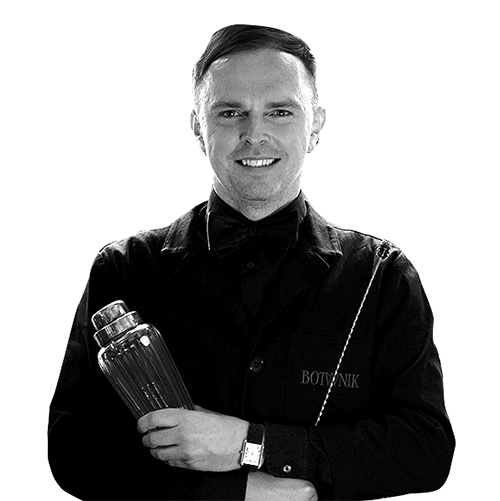
Andres is head mixologist and owner of Botaanik, an experiential cocktail bar where the menu pays homage to fruit, herbs and botanicals. You’ll find it on the edge of Tallinn’s historic Old Town.
www.botaanik.ee
Eat
With so many places and events listed online, I wanted to share something secret that cannot be found without the help of a local: a place called Biblioteq Library of Events, which specialises in private dining and parties.
Pamper
Situated in a hidden courtyard in the Old Town, Artisan Ateljee is a private salon for hair and for art. No walk-ins, only reservations and only two hair stylists, very intimate and premium. Check out the Estonian art on the walls.
Visit
Fotografiska Tallinn is hardly a secret, yet it’s a great place to lose yourself in photographic reveries. Plus, the restaurant NADA by Fotografiska has a chef’s table on Friday and Saturday nights where nothing, nada, is wasted.


